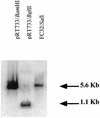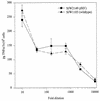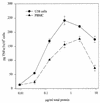Salmonella flagellin induces tumor necrosis factor alpha in a human promonocytic cell line
- PMID: 9488405
- PMCID: PMC108025
- DOI: 10.1128/IAI.66.3.1127-1134.1998
Salmonella flagellin induces tumor necrosis factor alpha in a human promonocytic cell line
Abstract
During infection of the gastrointestinal tract, salmonellae induce cytokine production and inflammatory responses which are believed to mediate tissue damage in the host. In a previous study, we reported that salmonellae possess the ability to stimulate tumor necrosis factor alpha (TNF-alpha) accumulation in primary human monocytes, as well as in the human promonocytic cell line U38. In this model system, cytokine upregulation is not due to lipopolysaccharide but is mediated by a released protein. In the present study, TnphoA transposon mutagenesis was used to identify the TNF-alpha-inducing factor. A mutant Salmonella strain which lacks the ability to induce TNF-alpha was isolated from a TnphoA library. Genetic analysis of this mutant demonstrated that the hns gene has been interrupted by transposon insertion. The hns gene product is a DNA-binding protein that regulates the expression of a variety of unrelated genes in salmonellae. One of the known targets of histone-like protein H1 is flhDC, the master operon which is absolutely required for flagellar expression. Analysis of other nonflagellated mutant Salmonella strains revealed a correlation between the ability to induce TNF-alpha and the expression of the phase 1 filament subunit protein FliC. Complementation experiments demonstrated that FliC is sufficient to restore the ability of nonflagellated mutant Salmonella strains to upregulate TNF-alpha, whereas the phase 2 protein FljB appears to complement to a lesser extent. In addition, Salmonella FliC can confer the TNF-alpha-inducing phenotype on Escherichia coli, which otherwise lacks the activity. Furthermore, assembly of FliC into complete flagellar structures may not be required for induction of TNF-alpha.
Figures



References
-
- Ambler R P, Rees M W. ε-N-Methyl-lysine in bacterial flagellar protein. Nature (London) 1959;184:56–57. - PubMed
-
- Andreana A, Gollapudi S, Kim C H, Gupta S. Salmonella typhimurium activates human immunodeficiency virus type 1 in chronically infected promonocytic cells by inducing tumor necrosis factor-α production. Biochem Biophys Res Commun. 1994;201:16–23. - PubMed
-
- Arnold J W, Klimpel G R, Niesel D W. Tumor necrosis factor alpha (TNFα) regulates intestinal mucus production during salmonellosis. Cell Immunol. 1993;151:336–344. - PubMed
-
- Arnold J W, Niesel D W, Annable C R, Hess C B, Asuncion M, Cho Y J, Peterson J W, Klimpel G R. Tumor necrosis factor-α mediates the early pathology in Salmonella infection of the gastrointestinal tract. Microb Pathog. 1993;14:217–227. - PubMed
-
- Atlung T, Ingmer H. H-NS: a modulator of environmentally regulated gene expression. Mol Microbiol. 1997;24:7–17. - PubMed
Publication types
MeSH terms
Substances
Grants and funding
LinkOut - more resources
Full Text Sources
Other Literature Sources

